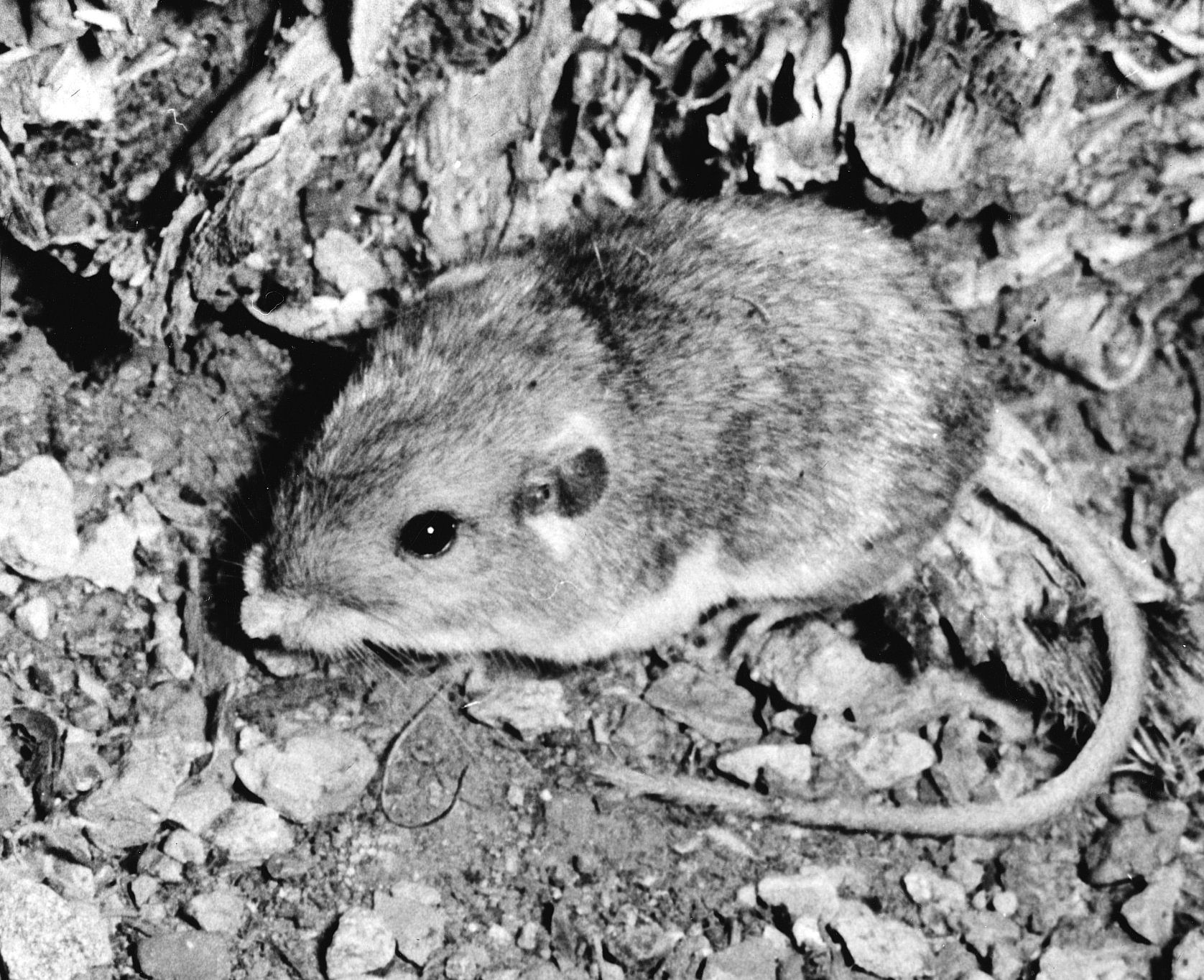MERRIAM'S POCKET MOUSE
Perognathus merriami Allen 1892
Order Rodentia : Family Heteromyidae
DESCRIPTION. A very small, silky-haired pocket mouse, similar to but slightly smaller than P. flavescens; upperparts ochraceous buff mixed with black; sides brighter, less blackish; underparts clear white; spot behind ear clear buff, the one below the ears white; eye ring light; tail slightly darker above than below; winter pelage brighter than in summer; young grayer, less ochraceous. Dental formula: I 1/1, C 0/0, Pm 1/1, M 3/3 × 2 = 20. Averages for external measurements: total length, 116 mm; tail, 57 mm; hind foot, 16 mm. Weight, 7–9 g.

DISTRIBUTION. Known from western two-thirds of state but absent from extreme northern Panhandle and extreme western Trans-Pecos where P. flavus occurs.

SUBSPECIES. Probably P. m. gilvus in the western part of the Panhandle, Trans-Pecos, and western Edwards Plateau and P. m. merriami in the eastern part of the Panhandle, eastern Edwards Plateau, and South Texas.
HABITS. In southern Texas these tiny pocket mice are most common on sandy soils where vegetation is sparse or at least short. In Trans-Pecos Texas they are more common on stony and gravelly soils covered with sparse vegetation. On the Edwards Plateau they are found in rocky habitats with interspersed midgrass species, such as sideoats grama, and in grassland valley habitats. They seem to have difficulty in traveling through heavy vegetation, and if forced into grass several centimeters high, their progress is materially impeded. Near Oiltown, Texas, they were especially common in stands of low Bermuda grass on the shoulders of the highway where they were gathering seeds. These pocket mice are found in soil substrates ranging from sandy, deep soils to clay, shallow soils.
During cold periods, Merriam's pocket mice become torpid in their burrows, but they do not hibernate. They remain in torpor for only about 24 hours. Seed stores within the burrow are utilized during periods of cold weather, and they also feed on stored seeds before emergence from burrows in the evening hours.
Burrows are small and are usually dug at the base of a shrub or a clump of cactus.
Several were also found in the nearly vertical banks left by road graders at the sides
of the highway right-of-way. One den consisted of three tunnels, 30–45 cm in length,
which converged under a flat rock to a nest chamber about the size of a man's fist.
Burrow diameter is about finger size. These mice also make use of abandoned burrows
of pocket gophers. Silky pocket mice are solitary in habit, except for a female and
her offspring.
Their food consists largely of seeds of various grasses and weeds. They also feed
on juniper seeds and other fruits if available. Insects make up a minor percentage
of the diet. They do not drink free water; instead they extract metabolic water from
their food sources. Merriam's pocket mice are rather sedentary in nature and have
small home ranges.
The breeding season appears to extend from April to November, and possibly two or more litters of three to six young are reared each season. The gestation period is 26 days or longer in duration. Young in gray juvenile pelage have been captured in June, July, and late November. In 1962, in the Big Bend region, Richard Porter found that the annual population turnover was 84%; in a 1958 study on the Black Gap Area and in Big Bend, Keith Dixon found the turnover to be 75%. Dixon recorded maximum life spans of 33 and 22 months, respectively, for two mice on the Black Gap.
POPULATION STATUS. Common. Merriam's pocket mouse remains common throughout its range in the state.
CONSERVATION STATUS. The IUCN lists Merriam's pocket mouse as a species of least concern, and it does not appear on the federal or state lists of concerned species. It does not appear to face any immediate threats.
REMARKS. The taxonomic status of P. merriami has had a confusing history. In 1973 Don Wilson presented morphological evidence indicating that P. merriami and P. flavus represented one species and combined both under the name P. flavus.
Subsequent studies using genetic analyses have shown, however, that two species are represented. In 1991, using karyology and starch gel electrophoresis, Tom Lee (Abilene Christian University) and Mark Engstrom (Royal Ontario Museum) determined that although the two taxa are highly similar morphologically, they do not appear to interbreed in areas of sympatry. In 2006, Joel Brant (McMurry University) and Tom Lee subsequently demonstrated that the two species can be discriminated using five cranial and three external measurements. In 2010, Ron Van Den Bussche and colleagues (Oklahoma State University) used DNA sequence data to confirm that P. merriami was a distinct species from P. flavus. Thus, in the central Trans-Pecos region and perhaps in the northern Panhandle region, these nearly identical species of pocket mice occur together but are genetically isolated from each other.
From The Mammals of Texas, Seventh Edition by David J. Schmidly and Robert D. Bradley, copyright © 1994, 2004, 2016. Courtesy of the University of Texas Press.
Natural Science Research Laboratory
-
Address
Museum of Texas Tech University, 3301 4th street, Lubbock, TX 79409 -
Phone
806.742.2486 -
Email
nsrl.museum@ttu.edu

